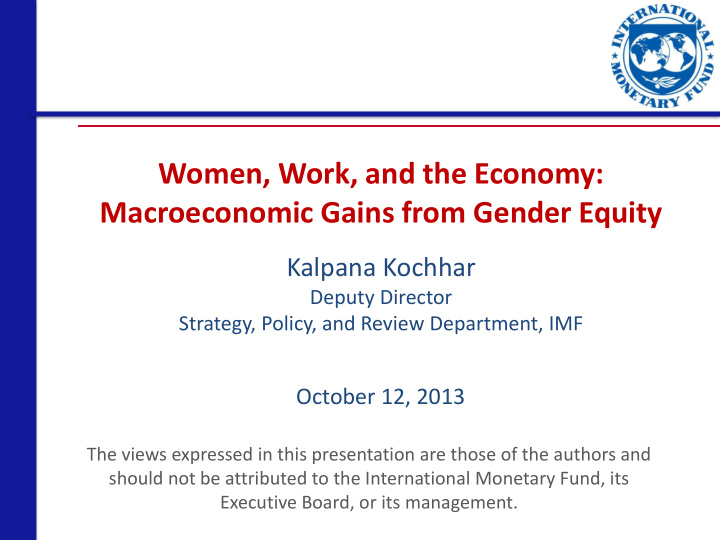



Women, Work, and the Economy: Macroeconomic Gains from Gender Equity Kalpana Kochhar Deputy Director Strategy, Policy, and Review Department, IMF October 12, 2013 The views expressed in this presentation are those of the authors and should not be attributed to the International Monetary Fund, its Executive Board, or its management.
Female Labor Force Participation Rates are Low in Many Countries… Source: World Bank, World Development Indicators, 2013; 3 Key Indicators of the Labour Market (KILM), ILO.
…and Stagnated at Low Levels Worldwide on Average. 70 East Asia & Pacific 60 Europe & Central Asia 50 Latin America & Caribbean 40 MENA South Asia 30 Sub-Saharan Africa 20 World 10 North America 0 1990 1995 2000 2005 2010 4 Source: World Bank, World Development Indicators, 2013; Key Indicators of the Labour Market (KILM), ILO.
Gender Gaps in Participation Rates Remain High. Gender Gap in Labor Force Participation, 1990 to 2010 (Male Minus Female Labor Force Participation Rates, in Percentage Points) 70 2010 1990 2000 60 50 40 30 20 10 0 Eastern OECD Southern Caribbean Eastern Western East Asia South Central Southern Middle and Africa Europe Africa and the America America Asia East and Middle and Pacific North Africa Central Africa Asia 5 Source: Key Indicators of the Labour Market (KILM), ILO. Country groups are based on UN Geoscheme and WB regional classification.
Why is this an issue for the IMF? 1. Women’s participation in the labor market is part of the growth and stability equation 2. The Fund, in collaboration with other IFIs, can contribute to level the playing field through: • Fiscal advice can take into account the potential gender-specific impact of measures • Improvement of gender-disaggregated data (with World Bank/OECD/ILO) 3
The Macroeconomic Gains from Raising Female Labor Force Participation 865 million women (Aguirre and others, 2012) have the potential to contribute more fully to national economies: Boost Economic Growth by Higher Female Labor force Mitigating the Impact of a Shrinking participation Workforce Higher School Enrollment for Greater Opportunities to Control Children and Stronger Human and Earn Income Capital Higher Productivity in Female Equal Access to Inputs Owned Companies Employment of Women on an Equal Improvement in Talent Pool Basis 6
Income Losses Due to Gender Gap by Region, in Percent Latin America and South Asia MENA the Caribbean 27 % 23 % 17% Europe and Central East Asia and the Sub-Saharan Africa Asia Pacific 12 % 15% 14% 7 Source: Cuberes and Teignier (2012)
The Macroeconomic Gains – Japan • With its population aging, Japan’s potential growth is falling • FLFP rates are well below OECD averages • Raising FLFP to G7 level would yield 4 percent GDP per capita gain and increase potential growth rate by 0.2 percentage points 8
Policies to Increase Female Labor Force Participation • Need to work on many margins • Employment , promotion, and wage policies – Access to education – Access to credit – Legal and property rights • Policies to facilitate balancing family and work responsibilities – Parental Leave – Child care – Flexible Work Arrangements 5
Policies to Increase Female Labor Force Participation • An integrated set of policies is needed • Focus of the presentation on one of the core area of expertise at the Fund: Fiscal Policies 5
Tax Measures Replacing family income with individual income taxation • Secondary earners are mostly women • Female labor supply more responsive to taxation than male labor supply Efficiency gains and better labor market outcomes Tax credits or benefits for low-wage earners • “In - work” credits reduce net tax liability increase net income gain from accepting a job • Phasing out with rise in individual income encourage secondary earners to remain in the labor force 5
Expenditure Measures • Publicly financed parental leave schemes • Greater parity in paternity and maternity leave • Improved access to comprehensive, affordable and high-quality child care • Pensions: ensure that spells from maternity leave do not translate into lower pensions • Higher spending on education of women • Improvements in rural infrastructure 5
Thank you! 2
Recommend
More recommend